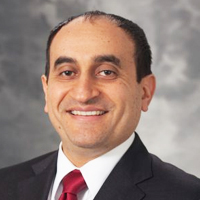Endoscopic Endonasal total Removal of a Suprasellar, Preinfundibular Retro Chiasmatic Craniopharyngioma: A Surgical Case Report
Published on: 26th March, 2024
Craniopharyngiomas are benign tumors (WHO Grade I), seen in children and adults. Because of their location, they can require challenging clinical and surgical management. In fact, often, because of the presence of calcifications, of a capsule very strongly adherent to neurovascular structures, of the relationship with hypophysis, pituitary stalk, chiasm, carotids, the circle of Willis, basilar artery, and third ventricle, risk of mortality and morbidity is still mandatory. Various surgical techniques have been proposed: transcranial, transsphenoidal, and supraorbital approaches for surgical resection and treatment of craniopharyngiomas. Still, there is no common consent, but often the endonasal transsphenoidal extended procedures are considered the gold standard in many cases. We present a surgical technique of a case of complete surgical removal of an infundibular and retro chiasmatic craniopharyngioma, via an endoscopic endonasal transphenoidal transplanum approach.
Approaching Mental Health Through a Preventive Data Analysis Platform
Published on: 3rd April, 2024
The rising prevalence of chronic diseases and the aging population globally are diminishing the overall quality of life, especially for those with demanding daily routines. As medical advancements extend lifespans, the proportion of individuals over 60 is set to double by 2050, necessitating societal shifts toward health-responsible citizenship. Despite longer lifespans, evidence suggests that older age often accompanies mental health challenges such as anxiety, depression, and substance misuse. Social isolation and loneliness further compound these issues, affecting both physical and mental well-being. Digital wellness empowers individuals to take charge of their health, promoting proactive care and literacy to foster health-conscious citizenship. This paper explores the intersection of mental health, aging populations, preventive wellness initiatives, and health literacy, emphasizing their significance within the Health 5.0 framework, especially for older adults. Traditionally, health regulators offer static workflows for adopting standard procedures in health and well-being, reflecting a reactive approach. However, the evolving landscape of wearable and mobile devices connecting to healthcare IT systems through secure online networks necessitates a shift. Technology now facilitates remote patient monitoring and telemedicine service subscriptions and empowers individuals to manage their health proactively.The BE4YOU project, conducted in Portugal, serves as a case study, facilitating individual maintenance of health and well-being through intelligent and dynamic workflows, which are defined based on analytical models considering each person’s risk profile. By facilitating data sharing, promoting healthy lifestyles, and enabling early detection of mental health issues, the project leverages technology to support personalized monitoring and enhance overall health outcomes. Through technology-driven empowerment, individuals and healthcare professionals are better equipped to assess risks and ensure ongoing wellness monitoring, underscoring the role of technology in fostering personal health and supporting healthcare effectiveness.
Oral Cancer Management is not just Treatment! But also, how early Pre-cancerous Lesions are Diagnosed & Treated!!
Published on: 12th April, 2024
Oral Cancer (OC) or squamous cell carcinoma of the oral cavity accounts for approximately 3% of all cancers worldwide, with increased incidence in developing countries. The use of tobacco is directly associated with approximately 80% of oral cancers, especially in older men over 40 years of age. As nearly one-third of the Indian population over 15 years consume smokeless tobacco in one or the other forms, a recent increase has been observed in OC incidence among women and young adults. Lately, the sexual behaviors of young & homosexuals have resulted in the emergence of oropharyngeal cancers due to infection with HPV 16. About 60% of oral cancer cases in India have a five-year survival rate, and this can be improved to 70% to 90% by mere early detection in stages I and II and with various treatment modalities. Despite the well-known benefits of oral cancer screening for the whole population in developing countries remains controversial. It is imperative to address the cultural barriers and societal norms, which limit the acceptability and participation in screening programs in India and many developing countries. This unique challenge of increasing OC morbidity in India and developing countries requires horizontal integration of the health systems with new services focused on cancer control, which gives the best chance for long-term survival, improved outcomes, and affordable care!This article is based on the author’s experience of overseeing 1 case of early detection and 2 cases of delayed diagnosis, outcomes and relevant literature review, and current guidelines for the management of OC.
Chronic Ethanol Decreases the Left Ventricular Cardiac Performance
Published on: 15th April, 2024
Introduction: Spaced fiber bundles, less evident cell striations, deposition of collagen fiber bundles, and increased presence of fibroblasts in the cardiac tissue of rats that voluntarily and chronically ingested ethanol were observed by our research group. In addition, we observed increased proliferation and cell death of cardiomyocytes. To find out whether these changes lead to impaired heart functionality, some clinical tests were performed. Aim: to investigate whether chronic ethanol decreases the left ventricular performance assessed by exercise testing, electrocardiogram, and echocardiogram of male and female UChB strain rats. Material and methods: ten adult males and ten adult females, Wistar strain rats, named UChB (University of Chile), spontaneous high ethanol drinkers (consumption greater than 2 g ethanol / Kg body weight/day), and ten male UChB rats and ten adults female UChB rats, not exposed to ethanol, UChBC rats (controls) were used. Cardiac performance was evaluated by the stress test, electrocardiogram, and echocardiogram. Results: Exposed females showed ventricular morphological changes in the heart. The exposed females and males had the highest heart relative weight with females being larger than males. The exposed females showed altered electrocardiogram and echocardiogram. Conclusion: Chronic ethanol decreases the left ventricular cardiac performance in rats. Females are more sensitive to changes in cardiac electrical conduction.
Macitentan in Adults with Sickle Cell Disease and Pulmonary Hypertension: A Proof-of-Concept Study
Published on: 22nd April, 2024
Pulmonary hypertension (PH) in sickle cell disease (SCD) is associated with a mortality rate of 37%. There is an upregulation of adhesion molecules which leads to the expression of endothelin-1, a potent vasoconstrictor. A prospective, descriptive study was done to determine the safety and efficacy of macitentan in patients with SCD and PH. Continuous variables were reported as mean ± SEM or percentage where appropriate. We screened 13 patients and recruited five. All five patients were adults. Data were analyzed as appropriate by student t - test. Statistical significance was assumed at p < 0.05. Baseline pulmonary hemodynamics obtained by right heart catheterization and systemic hemodynamics were (± SEM): mean pulmonary artery pressure (MPAP) 32 ± 8 mmHg, right atrial pressure (RAP) 9 ± 4 mmHg, pulmonary vascular resistance (PVR) 257 dynes-sec/cm5 and CI 3·7 ± 0.39 l/m2. Of all parameters, only PVR and 6-min walk distance changed significantly. For the group, MPAP decreased by 15.6%, PVR by 22.5% and RAP by 25.5%. The 6-minute walk distance increased over sixteen weeks except in Patient 4 who had a 3% decrease. The mean walk distance increased in the total distance, from 464 ± 158 meters to 477 ± 190 meters (p .123). In four patients, the adverse events were mild to moderate and did not lead to study drug discontinuation. Significant improvement in pulmonary hemodynamics and exercise capacity in patients with SCD-related pulmonary arterial hypertension. We found that macitentan was safe and well tolerated.
Designing a Community Health Worker (CHW) Certificate Training that Centers Marginalized Youth’s Health and Wellness
Published on: 23rd April, 2024
The genesis of the youth Community Health Worker (CHW) and Citizen/Community Science (CS) training is rooted in interdisciplinary research and the lived experiences of families in Chicago and Urbana-Champaign. Dr. Mendenhall and colleagues’ (Drs. Robinson, Roberts and Rodriquez-Zas) South Chicago’s Black Mothers’ Resiliency Project provide dinsights into Black women’s experiences with genomics, trauma, and community science. Black women’s testimonies highlighted the health impacts of living in neighborhoods with high levels of gun violence and the resilience strategies they employ. This led to the development of a youth-centered CHW and CS training program, aimed at addressing health disparities. The program trained high school students and young adults (up to age 24) as CHWs and CSs, focusing on the objectives of (1) embedding culturally competent health workers in marginalized communities; (2) amplifying community voices; (3) collecting, analyzing, and quantifying observational data to inform policy decision-making; (4) amplifying community voices in healthcare discussions and (5) creating community health care worker training certification for youth. Over three years, the program trained over 50 participants, incorporating elements of wellness, art, and entrepreneurship.Based on ethnographic notes participants reported increases in wellness such as reduced anxiety and increased empowerment. The program’s long-term goals include creating employment opportunities for graduates and contributing to improved community health outcomes. This initiative represents a step towards addressing racial trauma and promoting community healing through youth-led innovation and empowerment.

HSPI: We're glad you're here. Please click "create a new Query" if you are a new visitor to our website and need further information from us.
If you are already a member of our network and need to keep track of any developments regarding a question you have already submitted, click "take me to my Query."
















